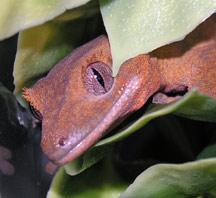Crested Geckos
Rhacodactylus ciliatus
 The Crested Gecko is one of the best choices to keep as a reptile pet in my opinion. They are docile, handleable and very easy to take care of.
The Crested Gecko is one of the best choices to keep as a reptile pet in my opinion. They are docile, handleable and very easy to take care of.
Crested Geckos thrive at temperatures between 65 and 80 degrees, room temperature in many homes, thus making supplemental heating unnecessary. They do not generally require expensive UVB lighting like some other species since they are nocturnal.
They will eat a prepared diet called aptly enough "The Crested Gecko Diet" which is produced by Allen Repashy in addition to mashed fruits/baby food with dusted (with calcium) crickets and other small insects.
Crested Geckos do need a few specific things to thrive in captivity:
Ample Cage Space
These geckos do a fair amount of jumping around at night and need enough space to get some excercise. A taller tank/cage is recommended. For hatchlings/juveniles a 10 gallon tank tipped on its side the tall way makes a good starter tank. The Exoterra front opening glass cages are also excellent choices. For an adult 20 gallons is suitable. For a pair or trio at least a 30 gallon or similar enclosure is recommended.
Humidity
Crested Geckos need a rather high level of humidity to do well. This can be accomplished rather easily with daily (or several times daily) misting with good old water. A substrate that holds moisture such as bed a beast can be utilized as well and kept damp but not wet. I mist my guys when I wake up and before I go to sleep at the very least. It gets pretty dry here in the Northeast in the winter so I do a lot of misting then. In the summer be careful you don't over humidify them as you can start to get mold.
Proper Temperatures
Temperatures for these guys are pretty simple. Generally they can stay at "room temperature" providing your temperatures are in the 60s into the high 70s. These guys can't take excessive heat and will stress out when the temperatures go over 85. If your home gets below the recommended range you can use a reptile heating pad along the side or back of the cage. Alternatively you can use a weak red light overhead to get the temperatures up a bit. Be careful in the summertime when temperatures can spike.
Branches & Sticks &Hides oh my
These guys come from areas that have loads of cover. Provide them with lots of branches, trees, sticks etc so they can climb around and feel secure. Also provide them with a hide box that they can retire to by day or when stressed.
Substrate
And here we come to one of the most highly contested subject in herp care. Substrates. On the one hand paper towels or cage carpet are favored for cleanliness, ease of use and also carry no risk of impaction. On the other hand substrates such as bed-a-beast or coconut fiber look more natural and hold moisture well. Unfortunately there is always a risk of impaction when using any particulate substrate. I choose to use the bed-a-beast type of bedding. Read up on this and make your own decision.
Proper Diet
In the wild Crested Geckos eat insects and fruits and nectars. There are a couple of ways to go about duplicating this in captivity. One popular diet is "The Crested Gecko Diet" or CGD as it is commonly called. This diet is an complete and excellent source of food for these guys. It comes in a powder and you mix it up as needed. It can be found at Pangea Reptile and several other places online as well as at your local pet shop under the T-Rex label. Alternatively Crested Geckos can be fed a combination of fruit baby food and *dusted insects such as crickets and small cockroaches. Mealworms are not recommended as they are hard to digest and not as nutritious. Many people choose to feed a combination of all these things. Variety is a good thing so mix it up a bit.
*note - by dusting we mean dust with a straight calcium powder frequently, calcium with D3 two to three times per week, & with a vitamin/mineral supplement (which doesn't contain phosphorous) several times per week also.
Supplementation
If you use the CGD listed above you should have only have to use supplements in a very limited fashion. Breeding females should be supplemented with calcium either added to the CGD or dusted onto insects. Other popular supplements to be used sparingly are Minerall and Herptivite. If using a more insect heavy diet with baby food these supplements should be used more often, perhaps 2x a week. If using baby food I would add a pinch of straight calcium powder every feeding.
Helpful Links
Where to find Crested Geckos
- JSRhacs - Jen & Steph breed awesome, healthy geckos. Located in Michigan
- Pangea Reptile - Matt's geckos are awesome. Located in Michigan
- Royal Reptilia - Limey is in NY and attend many shows on the East Coast.
- Chewie Chick's Reptiles - Bea has a great selection of healthy geckos. Also in NY.
- Genevieve's Geckos - Nice, healthy geckos. Attends the White Plains NY show
- Down East Herps - Located in Maine.
© 2005, www.reptilecare.com. All rights reserved.
